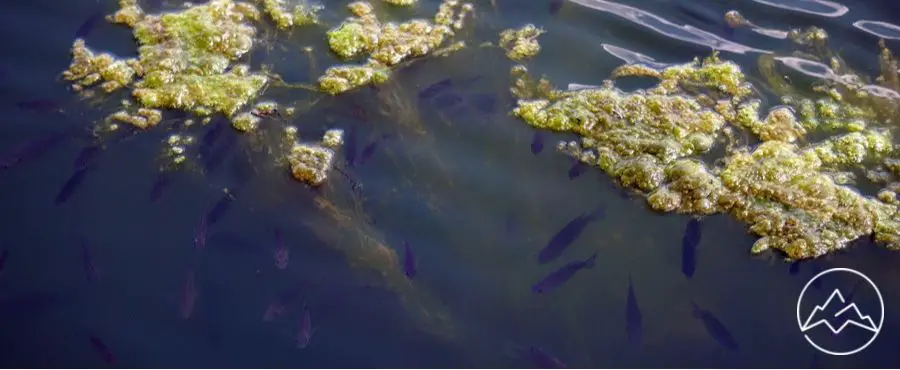Having appealing bait and knowing where to fish yield better results. Follow these best bluegill fishing tips to improve the amount and size of your bluegill catch.
Habitat
Bluegill fish prefers deep beds in rivers and ponds with a lot of weed cover. If sunken channels or islands are not readily available, you can find better bluegill fishing spots under piers or shaded areas with tree cover.
These deep, shaded areas provide better nesting for bluegill spawning and protection from anglers fishing at the surface for smaller fish. These underwater nooks also offer stable food and water conditions throughout the summer months. When bluegill fishing in these deeper waters, use heavy spoons that will quickly reach the bottom and kick up some debris to catch the bluegill’s attention.
When to go bluegill fishing
You can go bluegill fishing all year long. Bluegills tend to move to different locations in lakes and streams depending on temperature and season, but these bluegill tips tell you where to look no matter the season.Spring or early summer
As waters warm and their temperatures rise to 70 degrees, bluegill will begin to come up to more shallow water to spawn and feed. Male bluegill fish guard their nests against predators, so be mindful not to spook them. When bluegill fishing in these spawning months, cast your line out beyond the bluegill nests and retrieve the bait through the colony. Since bluegill fish are so protective of their nests, they can be vulnerable to anglers because they will try to attack perceived threats to their nest. For this reason, some anglers prefer to go bluegill fishing in the spring and early summer.Late summer
Toward the end of the summer months, and after spawning season, bluegill fish will head for deeper pools and channels. When bluegill fishing in the late summer, look for these fish to be down at least ten feet. Plan to go out in the early morning or evening when they are most active.
Autumn
While bluegill fishing tends to be similar from late summer to autumn, you will have more success with afternoon fishing as the weather starts to cool, and the water stays colder throughout the day.
Winter
Winter is not an ideal time to go bluegill fishing, but they will still bite. In these cold, winter months, bluegills migrate down to waters 12 to 20 feet deep. Bluegill fish do not actively feed in the winter and bite very lightly. Bring a light tackle and line to fish because it will be more sensitive to these light bites.
Best bait for bluegill fishing
Despite their size, bluegill fish have small mouths, so a small hook and light tackle works best when bluegill fishing. Bluegill fish are attracted to live, active baits of insects they would find in their habitat. These baits work well to attract bluegill:
- Crickets
- Worms
- Grasshoppers
- Nightcrawlers
Be sure to check out our guide on the best baitcasting reels.
Bluegill fishing tips and techniques
There are different methods for bluegill fishing. Some techniques may work better during different seasons and weather conditions.
Fly fishing
Small insects are a significant part of the bluegill fish’s diet, so fly fishing is an exciting and effective technique for bluegill fishing.
Small, black flies work best for bluegill fishing, but most fly patterns will work.Bobber fishing
Bobber fishing is the easiest method to use when fishing with your family because it is easy for children and effective. Bobber fishing is the most effective technique to catch bluegill fish in the spring and early summer months when they are nearest to the surface of the water.Having a slip bobber will allow you to go snag bluegill when they are at any level under the water, but generally, you want your bobber set at one to three feet deep. Attach a small bait, like a worm, to your bobber to attract more bluegill fish (this is my personal favorite, and kids tend to love using live bait).
Drift fishing
Drift fishing for bluegill is most effective in the late summer and autumn months because you can cast down ten to 15 feet. Fish are less cautious around boats without outboard motors, so using a kayak or canoe may catch more big bluegills. Bluegill fish travel in schools. Once you have caught a bluegill fish in a particular spot, drift through that area again to find others.
Bottom fishing
Bottom fishing is most effective in deeper water or following cold weather. To get the most from bottom fishing, use a lightweight bait and allow it to slowly sink to the bottom of the lake or pond you are fishing in. Bluegill fish may let go of bait that they feel resistance to, so it is essential to use ultra-lightweight bait when bottom fishing.
FAQs About Bluegill Fishing
What is the best time to fish for bluegill?
What kind of bait should be used when fishing for bluegill?
How can I determine if a body of water has good populations of bluegill?
What type of lures are best for catching bluegills?
Is fly fishing an effective method for targeting and catching Bluegills?
The bottom line
Bluegill fishing is a popular sport fishing among anglers. You can catch them throughout the year, and some people enjoy the taste of this fish. Following these best bluegill fishing tips will help you find the right bait and fishing spots to catch big bluegill, all year long.



